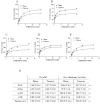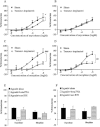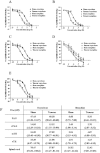Differential activation of the μ-opioid receptor by oxycodone and morphine in pain-related brain regions in a bone cancer pain model
- PMID: 22889192
- PMCID: PMC3572564
- DOI: 10.1111/j.1476-5381.2012.02139.x
Differential activation of the μ-opioid receptor by oxycodone and morphine in pain-related brain regions in a bone cancer pain model
Abstract
Background and purpose: Bone cancer pain is chronic and often difficult to control with opioids. However, recent studies have shown that several opioids have distinct analgesic profiles in chronic pain.
Experimental approach: To clarify the mechanisms underlying these distinct analgesic profiles, functional changes in the μ-opioid receptor were examined using a mouse femur bone cancer (FBC) model.
Key results: In the FBC model, the B(max) of [(3) H]-DAMGO binding was reduced by 15-45% in the periaqueductal grey matter (PAG), region ventral to the PAG (vPAG), mediodorsal thalamus (mTH), ventral thalamus and spinal cord. Oxycodone (10(-8) -10(-5) M) and morphine (10(-8) -10(-5) M) activated [(35) S]-GTPγS binding, but the activation was significantly attenuated in the PAG, vPAG, mTH and spinal cord in the FBC model. Interestingly, the attenuation of oxycodone-induced [(35) S]-GTPγS binding was quite limited (9-26%) in comparison with that of morphine (46-65%) in the PAG, vPAG and mTH, but not in the spinal cord. Furthermore, i.c.v. oxycodone at doses of 0.02-1.0 μg per mouse clearly inhibited pain-related behaviours, such as guarding, limb-use abnormalities and allodynia-like behaviour in the FBC model mice, while i.c.v. morphine (0.05-2.0 μg per mouse) had only partial or little analgesic effect on limb-use abnormalities and allodynia-like behaviour.
Conclusion and implications: These results show that μ-opioid receptor functions are attenuated in several pain-related regions in bone cancer in an agonist-dependent manner, and suggest that modification of the μ-opioid receptor is responsible for the distinct analgesic effect of oxycodone and morphine.
© 2012 The Authors. British Journal of Pharmacology © 2012 The British Pharmacological Society.
Figures







Similar articles
-
[(35)S]GTPγS binding and opioid tolerance and efficacy in mouse spinal cord.Pharmacol Biochem Behav. 2012 Mar;101(1):155-65. doi: 10.1016/j.pbb.2011.11.001. Epub 2011 Nov 12. Pharmacol Biochem Behav. 2012. PMID: 22108651
-
Enhanced GABAergic synaptic transmission at VLPAG neurons and potent modulation by oxycodone in a bone cancer pain model.Br J Pharmacol. 2015 Apr;172(8):2148-64. doi: 10.1111/bph.13039. Epub 2015 Feb 10. Br J Pharmacol. 2015. PMID: 25521524 Free PMC article.
-
Effect of estrogen on morphine- and oxycodone-induced antinociception in a female femur bone cancer pain model.Eur J Pharmacol. 2016 Feb 15;773:1-12. doi: 10.1016/j.ejphar.2016.01.001. Epub 2016 Jan 20. Eur J Pharmacol. 2016. PMID: 26802873
-
[Difference in tolerance to anti-hyperalgesic effect and its molecular mechanisms between chronic treatment with morphine, fentanyl and oxycodone in a chronic pain-like state].Nihon Shinkei Seishin Yakurigaku Zasshi. 2008 Nov;28(5-6):169-76. Nihon Shinkei Seishin Yakurigaku Zasshi. 2008. PMID: 19108502 Review. Japanese.
-
Neuronal and glial factors contributing to sex differences in opioid modulation of pain.Neuropsychopharmacology. 2019 Jan;44(1):155-165. doi: 10.1038/s41386-018-0127-4. Epub 2018 Jun 23. Neuropsychopharmacology. 2019. PMID: 29973654 Free PMC article. Review.
Cited by
-
Palliation of bone cancer pain by antagonists of platelet-activating factor receptors.PLoS One. 2014 Mar 17;9(3):e91746. doi: 10.1371/journal.pone.0091746. eCollection 2014. PLoS One. 2014. PMID: 24637403 Free PMC article.
-
Novel single nucleotide polymorphism biomarkers to predict opioid effects for cancer pain.Oncol Lett. 2023 Jul 4;26(2):355. doi: 10.3892/ol.2023.13941. eCollection 2023 Aug. Oncol Lett. 2023. PMID: 37545623 Free PMC article.
-
Nerve Decompression and Restless Legs Syndrome: A Retrospective Analysis.Front Neurol. 2017 Jul 6;8:287. doi: 10.3389/fneur.2017.00287. eCollection 2017. Front Neurol. 2017. PMID: 28729849 Free PMC article.
-
Comparison of oxycodone and morphine on the proliferation, apoptosis and expression of related molecules in the A549 human lung adenocarcinoma cell line.Exp Ther Med. 2016 Aug;12(2):559-566. doi: 10.3892/etm.2016.3346. Epub 2016 May 17. Exp Ther Med. 2016. PMID: 27446244 Free PMC article.
-
Updated Clinical Pharmacokinetics and Pharmacodynamics of Oxycodone.Clin Pharmacokinet. 2019 Jun;58(6):705-725. doi: 10.1007/s40262-018-00731-3. Clin Pharmacokinet. 2019. PMID: 30652261 Review.
References
-
- Basbaum AI, Fields HL. Endogenous pain control systems: brainstem spinal pathways and endorphin circuitry. Annu Rev Neurosci. 1984;7:309–338. - PubMed
-
- Basbaum AI, Jessell TM. The perception of pain. In: Kandel ER, Schwartz JH, Jessell TM, editors. Principles of Neural Science. New York: McGraw-Hill; 2000. pp. 472–491.
-
- Becker R, Jakob D, Uhle EI, Riegel T, Bertalanffy H. The significance of intrathecal opioid therapy for the treatment of neuropathic cancer pain conditions. Stereotact Funct Neurosug. 2000;75:16–26. - PubMed
-
- Bercovitch M, Adunsky A. High dose controlled-release oxycodone in hospice care. J Pain Palliat Care Pharmacother. 2006;20:33–39. - PubMed
MeSH terms
Substances
LinkOut - more resources
Full Text Sources
Other Literature Sources
Medical
Research Materials

